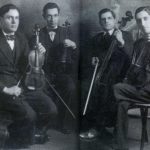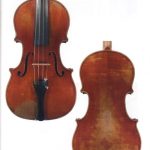The Strad magazine, December 2009 issue: In focus: Gaetano Sgarabotto
Copyright © 2009 Alberto Giordano – The Strad magazine. All rights reserved
MAKER
Born in 1878 in the north-eastern Italian town of Vicenza, Gaetano Sgarabotto attended a fine art school before dedicating himself to violin making. His first documented activity as an instrument maker dates from 1898 when he exhibited a harp, a mandolin, a mandolin–lyre with decorations and a violin in his hometown. In 1901 he settled in Milan, working under the direction of Riccardo Antoniazzi in the Bisiach workshop, which was then the most active workshop in Italy. There he had the opportunity not only to train as a violin maker but also to study old Italian instruments, on which he became an expert. Sgarabotto’s apprenticeship ended in 1905 when he returned to Vicenza and opened his own workshop, producing violins, violas and cellos. He continued to collaborate with Leandro Bisiach, making instruments ‘in the white’ for the Bisiach shop.
Sgarabotto remained in Vicenza until 1926, when he moved to Parma where he founded a violin making school attached to the city conservatory. He later worked in Vicenza, Brescia and finally Parma, where he died in 1959.
STYLE
A musician himself (he played violin in the Vicentino Quartet in the 1920s), Sgarabotto was a talented maker with great skill and experience. His fast and confident technique, combined with his knowledge of the Italian violin making tradition, enabled him to develop a versatile style. Along with the regular production of easily recognisable modern instruments made ‘in the new’, he made a considerable number of antiqued copies of classical instruments, especially in the early part of his career. His experience in Bisiach’s workshop improved his knowledge not only of Stradivari and Amati family models but also of G.B. Guadagnini and Gagliano, of which he made surprisingly good copies.
Sgarabotto’s influence on Italian modern violin making is strong: he trained a number of Italian makers. His son Pietro was also an accomplished maker and taught at the Cremona violin making school from 1959 to 1973.
HISTORY
This viola dates from 1920, within what was probably Sgarabotto’s best period. He made it for his son Pietro, who played it until 1940 when he sold it to the present owner.
The label indicates the model as an ‘imitazione classica’ (classical imitation) suggesting that rather than copying another instrument directly, the maker just followed his personal inspiration.
CRAFTSMANSHIP
Made with an interior mould, the viola has blocks and linings of willow, with the linings simply set on the corner blocks. The edgework was made with great care and skill, and the purfling is made of maple and ebony running in single pieces in the lower and upper bouts, creating elegant corners with delicate extensions. The archings are quite high and round (19.5mm top, 17.5mm back) but gently connected to the borders. The f-holes are from a model frequently used by Sgarabotto and they are set quite high, with high nicks as well, in order to reduce the string length; they show a delicate undercut and a medium-depth scoop.
The scroll reveals the fast workmanship that is typical of Sgarabotto’s work: the cut was left unsanded and the tracks of scraper and gouge are visible in several places. On the front of the instrument, the pegbox flanks are quite full with light chamfers recalling the Amati style.
- Back length: 400mm
- Upper bouts: 182mm
- Lower bouts: 235mm
- Stop length: 210mm
The Strad, december 2009





